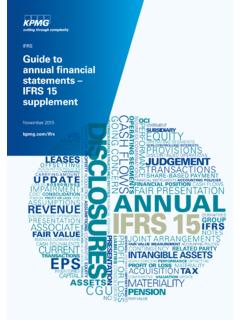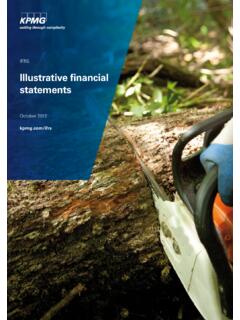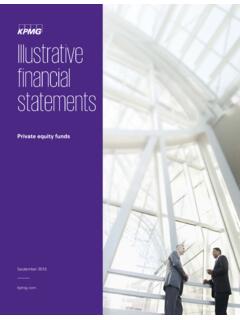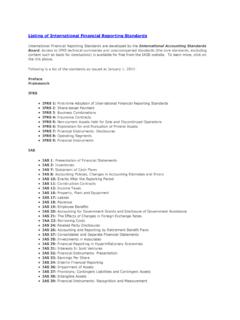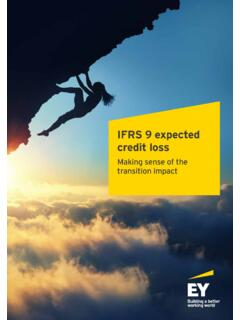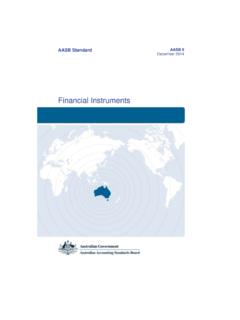Transcription of IFRS 16 – An overview - KPMG
1 ifrs 16 An overviewThe new normal for lease accountingMarch ifrs 16 at a glance Key facts Key application issues 32 Lessee accounting Lessee accounting model Initial measurement of the lease liability Initial measurement of the right-of-use asset Subsequent measurement of the lease liability Subsequent measurement of the right-of-use asset Recognition exemptions for lessees Presentation and disclosure 203 Lessor accounting Lessor accounting model Lease classification Operating lease model Finance lease model Presentation and disclosure 294 Lease definition overview Identified asset Economic benefits from using the asset Right to direct the use 405 Separating components overview Identify separate lease components Identify separate non-lease components Allocate the consideration Allocate the variable consideration 536 Lease term overview The non-cancellable period The enforceable period The reasonably certain threshold Renewable and cancellable leases Changes in the lease term 647 Lease modifications Definition Lessee modification accounting Lessor modification accounting 758 Sub-leases 809 Sale-and-leaseback 82 Appendix I: List of examples 86 Keeping in touch 88 About this publication 90 Acknowledgements 90 2021 KPMG IFRG Limited, a UK company, limited by guarantee.
2 All rights reserved. The new normal for lease accounting ifrs 16 Leases has now been successfully adopted by companies reporting under ifrs Standards. It is the new normal for lease accounting around the world. ifrs 16 had a significant impact on the financial statements of lessees with big-ticket leases, from retailers to banks to media companies. Although lessors found much that was familiar in ifrs 16, they faced new guidance on a number of aspects, from separating lease and non-lease components, to more radical accounting changes for more complex arrangements such as sale-and-leaseback transactions and sub-leases. Many implementation challenges have become day-to-day application issues. Some of these are technical accounting challenges identifying which transactions are or contain leases. Other challenges relate to systems and processes gathering the data required to drive lease accounting and support the ongoing judgements required to apply ifrs 16.
3 Some of these challenges could not have been foreseen. The COVID-19 pandemic has resulted in record numbers of changes to lease agreements. An in-depth understanding of ifrs 16 s detailed guidance on lease modifications is currently essential, and many lessees have taken advantage of the new practical expedient for rent concessions. This publication provides an overview of ifrs 16 s accounting models for lessees and lessors. It then takes a deeper dive into critical areas such as lease definition and accounting for lease modifications. If you are looking for a practical overview of ifrs 16, or just a refresher, you ve come to the right place. We have included examples and insights to help you understand the requirements and their impacts on the financial statements. If you want to know more, see our detailed publications on lease accounting available at Kimber Bascom Brian O Donovan Marcio Rost KPMG global ifrs leases leadership team KPMG International Standards Group2 | ifrs 16 An overview : The new normal for lease accounting 2021 KPMG IFRG Limited, a UK company, limited by guarantee.
4 All rights ifrs 16 at a Key facts This publication provides an overview of ifrs 16 and how it affects the financial statements of the lessee and the lessor. It includes examples and insights. The publication begins with an overview of the lessee and lessor accounting models, summarising the impact of ifrs 16 on their respective financial statements. To apply their respective models, the lessee and the lessor need to follow preliminary steps that are discussed in more detail in the subsequent chapters: identify the lease (see Chapter 4), separate components (see Chapter 5) and determine the lease term (see Chapter 6). The lessee will need to choose whether to apply the recognition exemptions (see Section ). The following diagram illustrates the relationships between key elements of the standard, and shows where each is discussed in this publication.
5 Many chapters include links to our more detailed guidance. You can also find more general guidance on ifrs 16 in Chapter in our publication Insights into ifrs and at 2021 KPMG IFRG Limited, a UK company, limited by guarantee. All rights ifrs 16 at a glance Key application issues Key application issues Applying ifrs 16 involves significant judgements and accounting policy elections that may impact the recognition of assets and liabilities, and their measurement. Applying the definition of a lease Assessing whether an arrangement is, or contains, a lease determines whether an arrangement is on- or off-balance sheet for a customer. The assessment can be complex and is required for each new contract. It includes consideration of: supplier s substitution rights: even if the supplier has the right to substitute the leased asset, there could still be a lease unless the supplier has the practical ability to substitute the asset throughout the period of use and it would benefit economically from the substitution (see ); and who takes the relevant decisions that affect the economic benefits arising from the lease asset throughout the lease term: this assessment can be particularly judgemental when both the supplier and the customer take some decisions, or many decisions are predetermined (see 2).
6 Determining the lease term The assessment of the lease term is a critical estimate and a key input into the amount of the lease liability for the lessee. For lessees, the lease term also determines whether a lease is eligible for the recognition exemption for short-term leases. For lessors, it affects lease classification and income recognition. Determining the enforceable period is complex when relevant laws and regulations in the local jurisdiction create enforceable rights and obligations in addition to those set out in the written lease agreement. Determining the broader economic penalties incurred by the lessee and lessor when exercising a termination right also presents interesting challenges (see Section ). Determining the lease term for renewable and cancellable leases, including assessing the enforceable period, was a complex implementation issue on which the ifrs Interpretations Committee has provided guidance (see Section ).
7 Lease modifications The guidance on lease modifications has been a key area of focus for many companies due to the economic impact of the COVID-19 pandemic (see Chapter 7). Key accounting policy choices and exemptions A lessee can elect not to apply the lessee accounting model to leases with a lease term of 12 months or less that do not contain a purchase option (by class of underlying asset) and leases for which the underlying asset is of low value when it is new (on a lease-by-lease basis) (see Section ). A lessee can elect, by class of underlying asset, to combine each lease component and any associated non-lease components and account for them as a single lease component (see Section ). A lessee may apply a practical expedient that simplifies the accounting for eligible rent concessions that are a direct consequence of the COVID-19 pandemic (see ).
8 Both the lessee and the lessor may apply the standard to a portfolio of lease contracts if certain conditions are met (see Section ).4 | ifrs 16 An overview : The new normal for lease accounting 2021 KPMG IFRG Limited, a UK company, limited by guarantee. All rights Lessee accounting The key objective of ifrs 16 is to ensure that lessees recognise assets and liabilities for their major Lessee accounting modelIFRS A lessee applies a single lease accounting model under which it recognises all leases on-balance sheet, unless it elects to apply the recognition exemptions (see Section ). A lessee recognises a right-of-use asset representing its right to use the underlying asset and a lease liability representing its obligation to make , 49 Is ifrs 16 a pre-tax accounting model?Yes. ifrs 16 continues to address lessee (and lessor) accounting on a pre-tax basis, even if tax considerations are often a major factor when a company is assessing whether to lease or buy an asset, and when a lessor is pricing a lease contract.
9 The income tax accounting for lease contracts is in the scope of IAS 12 Income Taxes. The complexities in accounting for income taxes by lessees of on-balance sheet leases include, for example, how to apply the initial recognition exemption. The International Accounting Standards Board (the Board) is expected to issue an amendment to IAS 12 addressing this issue. 2021 KPMG IFRG Limited, a UK company, limited by guarantee. All rights Lessee accounting Initial measurement of the lease liability Initial measurement of the lease OverviewIFRS A lessee initially measures the lease liability at the present value of the future lease payments. The key inputs to this calculation are as follows. When does a lessee first measure the lease liability? ifrs lessee initially measures the lease liability at the commencement date of the lease.
10 This is the date on which a lessor makes an underlying asset available for use by a lessee. The commencement date should be distinguished from the inception date of a lease, which is the earlier of the date of the lease agreement and the date of commitment by the parties to the principal terms and conditions of the lease. A company assesses whether a contract is, or contains, a lease at the inception lease liabilities financial liabilities? ifrs (b)Yes, lease liabilities are financial liabilities measured in accordance with ifrs 16 not ifrs 9 financial instruments . However, they are subject to the derecognition requirements of ifrs represents a considerable simplification compared with financial instruments accounting in some cases. For example, common features of lease agreements renewal and purchase options are not accounted for separately, nor do they have the potential to result in the liability being measured at fair | ifrs 16 An overview : The new normal for lease accounting 2021 KPMG IFRG Limited, a UK company, limited by guarantee.
